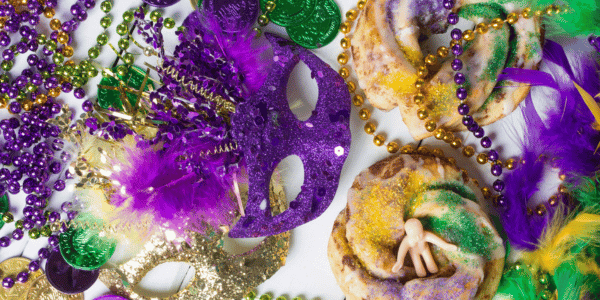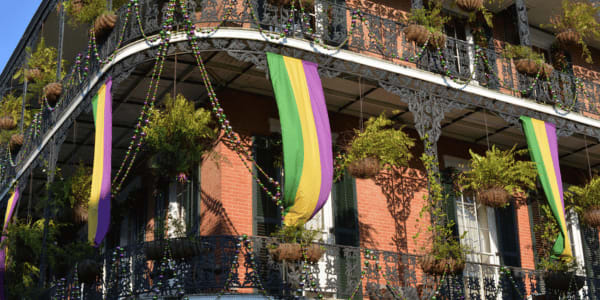Unlocking the Secrets Behind Mardi Gras and Its History

After experiencing the hubbub of the holidays, there’s a shining light of excitement and fun: Mardi Gras. Set for Tuesday, February 17, Mardi Gras 2026 promises awe-inspiring spectacles, time-honored revelry, and festivities galore. But what is Mardi Gras and why do we celebrate it? Read on to find out!
What is Mardi Gras?
Mardi Gras is the French term for Fat Tuesday. In Christian cultures, the day before Ash Wednesday, when Lent starts, is considered Fat Tuesday, or Mardi Gras. For thousands of years, revelers have feasted on decadent, fatty foods on this day in preparation for the fasting and meat restrictions that come with Lent.
Where Did Mardi Gras Originate From?
The roots of Mardi Gras date back to ancient times, when the Roman Empire instituted a traditional celebration that blended old pagan rituals to honor spring with newly established Christian tenets. As France adopted Christianity in the first century, pre-Lent festivities became known as Mardi Gras.
Synonymous with Carnival, which is recognized in many other Christian countries, merriment, debauchery, and excess in all forms were celebrated for weeks before culminating on the day before Ash Wednesday, the start of Lent. Lent, a somber period, included 40 days of fasting, penance, and eating only fish or vegetarian foods after sundown.
Fish is considered one of the five most powerful superfoods. Learn more about the top five superfoods here.
Mardi Gras History in New Orleans
French explorers Pierre Le Moyne d’Iberville and Sieur de Bienville were the first to establish Mardi Gras in the Americas. Catholics sent by King Louis XIV to claim land, the pair arrived near what is now New Orleans, Louisiana, on March 3, 1699—Mardi Gras day. To commemorate the holiday, they named their landing spot Point Du Mardi Gras, or Mardi Gras Point.
However, Bienville is also credited with founding the settlement of Mobile, Alabama, in 1702. And it’s widely reported that the first organized Mardi Gras celebration was actually in Mobile in 1703.

Mardi Gras Krewes and What They Do
Krewes are clubs that organize Mardi Gras festivities. The first krewe in New Orleans, the Mistick Krewe of Comus, staged a Mardi Gras parade, tableau (play), a presentation of debutantes, and a formal ball in 1853. Four other krewes were later created:
- Twelfth Night Revelers, 1870
- Knights of Momus, 1872
- Rex, 1972
- Krewe of Proteus, 1882
Including Comus, these five krewes make up what’s known as the Old Line Krewes. Shrouded in mysticism and secrecy, krewe members joined parades donned in masks and costumes and were the first to host masquerade balls. Krewes also had their own unique parade throws, tossing items and trinkets that had special meaning for their organization. Some of these krewes still exist today, along with many others.
Old Line Krewes leading the modern-day New Orleans Mardi Gras parade include Rex and Proteus.
Mardi Gras Colors and Their Symbolism
Mardi Gras is represented by a trio of green, purple, and gold colors. The three colors made their debut in the 1872 New Orleans Mardi Gras parade, which was themed “Symbolism of Colors.” A calculated choice, it’s believed that those specific colors were selected to honor Russian leader Alexei Alexandrovich Romanov, a Grand Duke visiting at the time.
The colors symbolize:
- Purple: Justice
- Green: Faith
- Gold: Power
Traditions and Customs of Mardi Gras
Steeped in tradition, Mardi Gras just isn’t Mardi Gras without its most iconic customs. The most recognized and long-lasting include:
Rex. The king of Mardi Gras first made his appearance as the carnival’s mascot in the Rex krewe parade of 1872. A larger-than-life way to honor Russia’s visiting duke, Rex continues to headline the parade today.
Parades. The mainstay of the celebration, parades are meant to join people in fun and merriment. There are several raucous parades in the days leading up to Mardi Gras 2025.
Flambeaux. When Mardi Gras parades began, enslaved people and freed African American men would light the procession carrying flamed torches, dancing and performing tricks in exchange for tips. The flambeaux continues as an important marker in history.
Masks. To protect their identities and maintain the secrecy of the society, krewe members would wear masks and costumes during parades and balls. A practice that gained momentum with officials and spectators alike, many carnival-goers followed suit to allow them to fully let down their guard.
Beads. Synonymous with “throws,” beads have been tossed since the 1890s when a Mardi Gras king threw fake jewels to the parade’s crowd. It’s estimated that more than 25 million pounds of beads are tossed yearly during New Orleans’s Mardi Gras.
King Cake. A circular-shaped, cinnamon-flavored dessert that’s iced with purple, gold, and green, a king cake recipe includes a little plastic baby in it, meant to represent baby Jesus. A cake that’s eaten to commemorate the three kings visiting Jesus, the tradition has lasted since Mardi Gras’ inception. Find baby Jesus and expect luck to soon come your way.

Delicious king cake can be made with all-purpose flour or bread flour. Check out our flour guide for more on all the different varieties!
Holiday Traditions From Around the World
Mardi Gras is celebrated globally, offering traditions with a wealth of history, meaning, and merriment. Still, some countries celebrate ancient customs that might surprise you. Read this article to explore eight unique worldwide holiday traditions rooted in history and demonstrating a rich cultural heritage.
Mardi Gras FAQs
Where is Mardi Gras celebrated?
Mardi Gras is celebrated in the United States cities of New Orleans, Louisiana, and Mobile, Alabama. Other countries that celebrate Mardi Gras include France, Italy, and Belgium.
When exactly is Mardi Gras 2026?
Mardi Gras 2026 is Tuesday, February 17, 2026.
What happens during Mardi Gras?
During Mardi Gras, people attend parades and balls. Many flock to New Orleans for a historical celebration, collecting beads from passing parade floats, drinking alcohol, eating king’s cake, and wearing masks and colorful costumes.
Who celebrates Mardi Gras?
French Catholics brought Mardi Gras to the Americas, but people from all religions and backgrounds celebrate it.